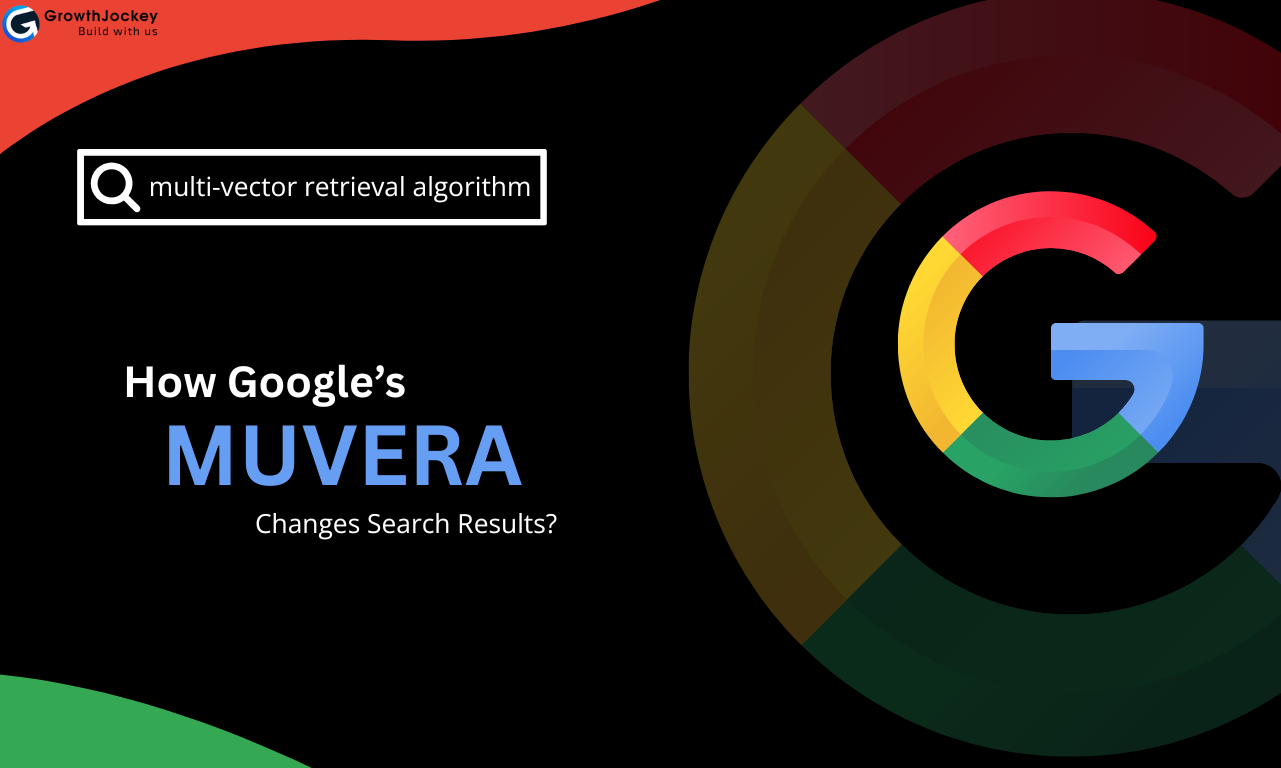How Google’s MUVERA Algorithm Update is Changing SEO Strategy?

In over six years of working in SEO, I’ve seen search evolve from keyword targeting to semantic indexing, from ten blue links to AI-generated answers. Every update - from Panda to BERT - has taught us how the Google ranking algorithm update improves content visibility.
But MUVERA is different.
It doesn’t change how Google ranks pages. It changes what even gets seen by Google in the first place. MUVERA restructures retrieval, the silent engine that decides which passages make it to the ranking layer - and which are ignored entirely.
If you work in SEO, content strategy, or technical optimization, this isn’t just another update to be aware of. MUVERA is the line between visibility and invisibility. And it’s already shaping how content is discovered - especially for those who want to stay ahead with retrievability optimization and AI-first SEO strategy.
What Is Google MUVERA Algorithm? What Does This Mean for SEO?
Most algorithm changes affect how pages are ranked. MUVERA changes what gets retrieved in the first place - and that’s a much deeper shift in how search engines evaluate content.
MUVERA stands for Multi-Vector Retrieval via Fixed-Dimensional Representations[1] - a new multi-vector retrieval algorithm designed to revolutionize document understanding.
In simpler terms, MUVERA allows Google to understand and retrieve multiple meaning blocks (or passages) from a single page - rather than representing the page as one big idea.
Before MUVERA, each document was encoded as a single dense vector - a compressed representation of the entire page. That vector was compared to the user’s query vector to decide what to retrieve.
Now, MUVERA breaks the page into multiple passage-level SEO embeddings - each representing a distinct subtopic or intent. These multiple vectors are then compressed into a fixed-size index. This enables transformer-based retrieval that’s both semantically rich and performance-efficient.

So what does this mean for SEO?
Pages are no longer evaluated as a whole. Instead, specific sections can be retrieved, scored, and surfaced independently. If your content isn’t structured with retrievability optimization, modularity, and clear intent signaling, it may never even be retrieved - no matter how well-written.
MUVERA doesn’t just reward great content. It rewards smartly structured content that mirrors how users think and search.
Where MUVERA Sits in Google’s Search Stack?
To understand MUVERA’s impact, we need to know where it fits in Google’s multi-stage search pipeline.
Here’s a simplified view of the journey:

Let’s simplify it:
User Query → MUVERA (Retrieval Layer) → Ranking Systems → SGE/Results Page
MUVERA is the gatekeeper. If your content isn’t retrieved, it’s invisible to the ranking system and the Search Generative Experience (SGE).
That makes retrievability optimization the new priority. We’re no longer just optimizing for visibility - we’re optimizing for presence in the first place.
This shift brings AI-first SEO strategy, semantic indexing, and transformer-based retrieval into the spotlight, changing the very definition of what SEO success looks like.
SEO Strategy Shifts Triggered by MUVERA
MUVERA doesn’t just modify how Google ranks content - it reshapes the entire journey of how content is retrieved, interpreted, and served. That means your old SEO playbook won’t cut it anymore.
Here’s a snapshot of the seismic shifts MUVERA is triggering - and how SEOs must evolve:
| SEO Element | Before MUVERA | After MUVERA |
|---|---|---|
| Retrieval Logic | Pages ranked by dense vector match to the full query | Multiple sparse vectors per query retrieve specific passages |
| Ranking Entry Point | Indexed page competes in SERP | Only retrieved passage chunks are even considered for ranking |
| Optimization Target | Keywords, TF-IDF, backlinks, global relevance | Semantic clarity, modularity, passage retrievability |
| Content Structure | Linear articles optimized top-down | Modular, standalone sections with retrievable headers |
| User Intent Matching | Matched at page level | Matched at sub-section/passage level |
| Technical SEO Lens | Crawlability, indexation, speed, sitemaps | Retrievability engineering – how AI models see and chunk your content |
Key Takeaways for SEOs
1. Being Indexed ≠ Being Retrieved
- If your content isn’t retrieved by MUVERA, it doesn’t get a shot at ranking - no matter how optimized your meta tags are.
- Retrieval is now the gatekeeper of rankings.
2. SEO Starts at H2, Not Just Title Tags
- Google may rank a paragraph nested under your H3, not the whole article.
- Each section must answer a query clearly and independently.
3. Ranking Factors Are Now Post-Retrieval
- Traditional ranking metrics (backlinks, E-E-A-T, Core Web Vitals) only matter after your passage is retrieved.
- MUVERA is the zero-filter - fail here and you’re invisible.
4. Semantic Signals Beat Surface Optimization
- Keyword stuffing is now noise.
- Instead, focus on semantic proximity and intent phrasing in each section.
9. Thin Content Dies Faster
- MUVERA prioritizes topical depth, not word count or keyword breadth.
- Shallow overviews won’t survive in a retrieval-first system.
Adapting SEO for MUVERA: Mindset Shifts and Action Plan
MUVERA changes the SEO game at a foundational level. It's not just another ranking signal — it decides what content even enters the race. So, our SEO approach must evolve from keyword placement to retrievability engineering.
Here’s a combined view of the strategic shifts MUVERA demands and the tactical actions to implement right away:
1. Retrieval Is the New Ranking Filter
Shift: Ranking starts at retrieval. If MUVERA doesn’t fetch your passage, nothing else matters.
What to Do:
- Structure every article with clear, standalone H2s that mirror search intent
- Optimize each section to function as a retrievable unit (150–300 words max)
- Ensure clarity upfront: context → answer → takeaway
2. Multimodal Content Isn’t Optional Anymore
Shift: MUVERA integrates with systems that process text, visuals, tables, and structured content.
What to Do:
- Use infographics, comparison tables, and charts to support your message
- Optimize images with proper alt text, captions, and contextual alignment
- Don’t rely on visuals for aesthetics - make them semantically meaningful
3. Passage-Level Optimization Beats Page-Level Bloat
Shift: MUVERA retrieves snippets, not entire pages.
What to Do:
- Treat every H2/H3 like a mini landing page
- Add clear intros and make every section self-sufficient
- Use bullets, examples, and analogies to enrich meaning
4. GEO vs SEO: Generative Experience Is the New Frontier
Shift: Your content isn’t just retrieved - it fuels AI summaries via SGE.
What to Do:
- Write clean, structured content that's AI-readable
- Avoid filler and repetition - LLMs penalize vague content
- Think: “Can this paragraph be quoted by a bot as-is?”
5. Semantic Interlinking Is the New Technical SEO
Shift: Google now connects meaning across pages - not just through sitemaps.
What to Do:
- Link to relevant sections, not just generic URLs
- Use anchor text that reflects searcher language
- Build content webs that mirror topic clusters, not folders
6. Topical Depth > Keyword Spread
Shift: Thin overviews won’t build the semantic weight MUVERA looks for.
What to Do:
- Create pillar content and surround it with deep, connected pieces
- Address niche use cases, FAQs, and edge-case questions
- Focus on intent clusters, not broad volume
7. Think Like a Model, Not a Crawler
Shift: MUVERA uses transformer-based encoders - not keyword counters.
What to Do:
- Write naturally using varied vocabulary
- Incorporate synonyms and semantic cues (e.g., “speed” → “performance”)
- Use real-world analogies to deepen comprehension (for both readers & AI)
Bottom Line: MUVERA doesn’t eliminate SEO - it elevates it. You’re not optimizing for robots anymore. You’re shaping content for AI models that retrieve, interpret, and summarize knowledge. Get that right, and you future-proof your content beyond the next update.
MUVERA, NLP, and LLMs: Why SEOs Must Think AI-First
Most SEOs optimize for how Google’s ranking algorithms evaluate content. But with MUVERA, we need to start thinking about how Google’s retrieval systems and AI models understand language - because they now shape what’s even seen.
MUVERA is powered by dense vector representations - essentially high-dimensional summaries of meaning. These embeddings aren’t just used for ranking; they are also the input layer for Large Language Models (LLMs) that drive things like SGE (Search Generative Experience) and AI Overviews.
So what does this mean for SEO?
MUVERA doesn’t just influence what is retrieved - it shapes how that information is interpreted and used downstream by generative AI. If your content is semantically weak, vague, or poorly structured, it will either:
- Never get retrieved
- Or be misunderstood by the model during generation
Key implications:
- Transformer Models Power Retrieval
MUVERA uses transformer-based encoders to generate embeddings. These models understand relationships between words, phrases, and sections - not just presence of keywords.
- Multimodal Inputs Matter More
As MUVERA and LLMs evolve, images, charts, and structured data will be used to enrich meaning - especially in content that feeds AI answers.
- The Retrieval → Ranking → Generation Pipeline Is Now Unified
What MUVERA retrieves is what ranking systems evaluate and what LLMs may summarize. It's a full-stack system - and retrievability is the first step.
| Layer | Purpose | SEO Focus Area |
|---|---|---|
| Retrieval (MUVERA) | Find the most relevant passages | Clear H2s, semantic intent, fast loading |
| Ranking | Evaluate quality, authority, UX | E-E-A-T, backlinks, engagement |
| Generation (SGE/LLMs) | Summarize or rephrase content | Structured content, clarity, AI-readability |
MUVERA is no longer just a backend innovation - it’s a front-door filter for AI-powered search. If your content isn’t optimized for semantic vectors, it may be invisible to the models shaping tomorrow’s SERPs.
MUVERA + SGE: A Powerful Combination
If MUVERA is Google’s new brain for finding information, then SGE (Search Generative Experience) is its voice for responding. Together, they reshape the entire search pipeline - from query to answer.
What MUVERA Does?
- Retrieves the most semantically relevant passages
- Uses multi-vector retrieval to capture meaning from different angles (intent, context, tone)
- Feeds only the best-suited content to ranking systems and language models
What SGE Does?
- Summarizes and rephrases the retrieved content
- Uses LLMs to generate concise answers for complex queries
- Displays generated snippets above organic results - pushing traditional blue links lower
Why MUVERA + SGE Duo Matters for SEO?
| Layer | Role | Impact on SEO |
|---|---|---|
| MUVERA | Retrieval | Determines if your content even gets seen |
| Ranking | Evaluation | Assesses content quality, authority, UX |
| SGE | Generation | Creates AI answers from your content |
If MUVERA can’t find your page, you won’t rank. If your passage isn’t clear and structured, SGE won’t summarize you.
Example:
Query: “Best way to reduce bounce rate on a blog”
- MUVERA identifies 3–5 highly relevant passage vectors from across the web
- SGE reads these and generates: “Reducing bounce rate involves improving page load speed, creating engaging above-the-fold content, and linking to related posts.”
Only well-structured, semantically rich content makes it into that answer.
MUVERA and SGE aren’t just updates. They’re a new information highway.
If you don’t optimize for retrieval and generation, you risk being left out of the future of search.
Conclusion: From Ranking to Retrievability - A New SEO Paradigm
MUVERA doesn’t just add another layer to Google’s algorithm - it reshapes the entire foundation. It moves SEO beyond rankings, keywords, and backlinks into the realm of retrieval-first content design.
For those of us who’ve been in SEO for years, this shift may feel subtle - but it’s profound. It’s a call to rethink how content is created, structured, and connected. In an ecosystem where SGE is rewriting answers and MUVERA is deciding what gets seen, every H2, every paragraph, every internal link becomes a gateway - or a dead end.
The future of SEO will belong to those who:
- Think in passages, not pages
- Write for meaning, not just metadata
- Embrace the reality that retrievability is the new visibility
We’re entering an era where ranking is just step two - step one is being found at all.
Stay curious. Stay adaptive. And start optimizing not just for search engines - but for the models that power them.
Frequently Asked Questions (FAQs)
What is Google’s MUVERA algorithm?
MUVERA (Multi-Vector Retrieval Architecture) is Google’s advanced retrieval system that selects relevant content using multiple semantic vectors instead of a single representation. It helps Google understand user intent more accurately before ranking results.
How does MUVERA differ from traditional keyword-based search?
Unlike traditional keyword matching, MUVERA uses AI models to interpret multiple meanings behind a query and fetch the most relevant passages, not just pages. It focuses on context, nuance, and user intent.
Why does MUVERA matter for SEO?
Because MUVERA works at the retrieval layer, it decides what content is even seen by Google’s ranking systems. If your content isn’t retrievable, it won’t rank - no matter how optimized it is otherwise.
Is MUVERA connected to SGE?
Yes. MUVERA feeds semantically rich content to systems like SGE (Search Generative Experience), which then generate AI-driven summaries. Together, they influence what gets retrieved, summarized, and shown in Google’s new SERP formats.
How can I optimize my content for MUVERA?
Focus on:
- Modular, intent-based sectioning
- Clear H2s and subtopics
- Semantic depth (examples, FAQs, comparisons)
- Internal linking across related concepts
- Using multimodal content like tables, visuals, and structured HTML
Will traditional SEO strategies still work?
Yes - but they’re not enough anymore. Keywords, backlinks, and technical SEO still matter, but they must be supported by retrieval-first design that aligns with how MUVERA fetches content.








